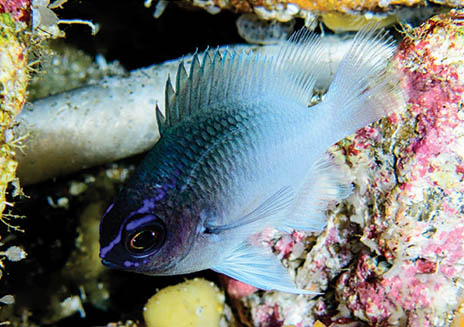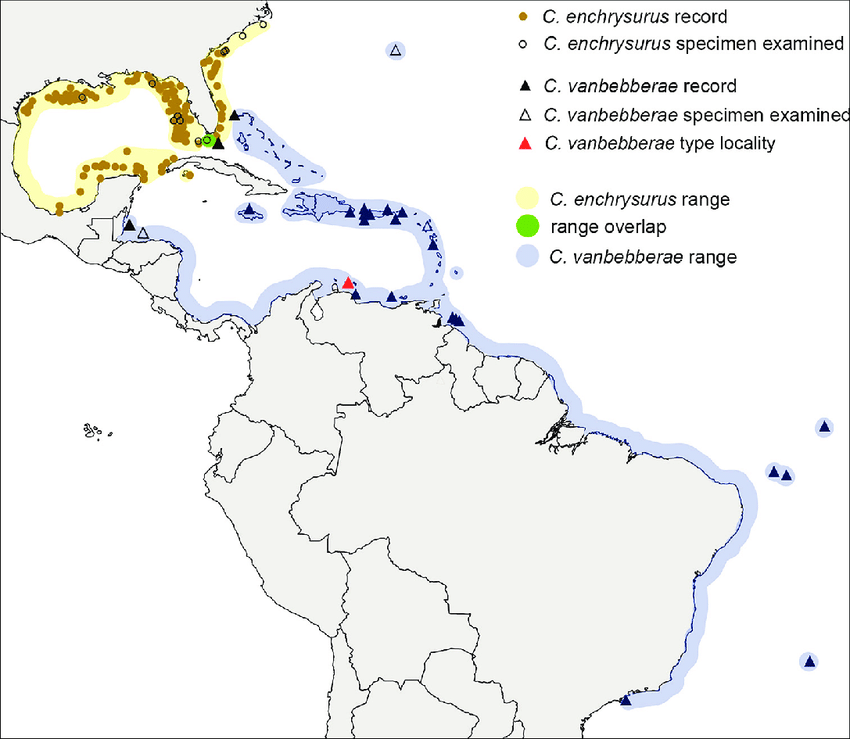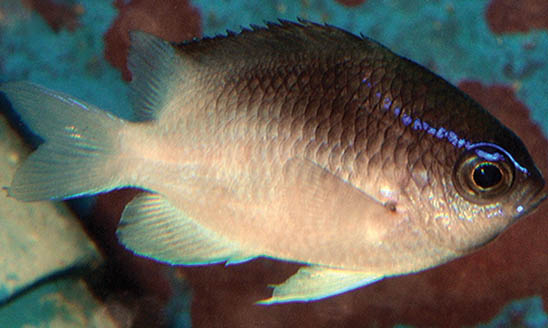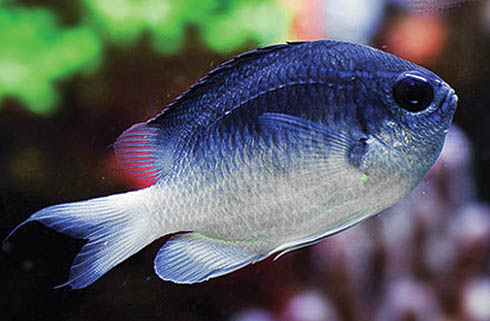
“The discovery of a new species within a conspicuous group such as damselfishes in a well-studied region of the world highlights the importance of deep-reef exploration in documenting undiscovered biodiversity.”
– McFarland et al.
Hiding among the deep reefs of the Western Atlantic, associating with the rather well-known Sunshine Chromis (Chromis insolata) and Purple Chromis (C. scotti), and initially mistaken as a color morph of the Yellowtail Reeffish (Chromis enchrysurus), and even being found in the waters of Southern Florida, the Whitetail Reeffish is now officially recognized as a distinct species, Chromis vanbebberae. The Whitetail Reeffish was in the ocean all along, but it took genetic research to uncover its true identity.
Striking Babies, But Somber Adults
Both sister species, the Yellowtail and Whitetail Reefish, offer visually breathtaking juvenile coloration. In the case of the long known Yellowtail, juveniles are a bold mix of a blue body, yellow posterior and fins, and a vivid electric blue slash running from the nose, through the eye, and up along the back. In the new Whitetail species, the yellow coloration is replaced by white; still a stunning specimen.

Sadly, as happens with far too many vividly-colored juvenile damselfishes, they grow up to be rather mundane adults. The Yellowtail Reeffish becomes brown, with a lighter belly, but still offering a bright yellow caudal fin, along with yellow on the posterior ends of the dorsal and anal fin. The new Whitetail Reeffish basically becomes a bicolor gray and white fish at maturity, with hints of its formerly gloriously blue coloration sometimes present.

Researchers also revealed that the ranges of these two related species are likely separate, with just one small area where they overlap; “Where C. vanbebberae and C. enchrysurus overlap in southeastern Florida, the two species segregate by depth, with C. enchrysurus occurring from (~ 25–40 m), and C. vanbebberae occurring in deeper water (~ 60–90 m).”

How Did It Take This Long To Recognize This New Species?
There are two reasons behind how this species went undescribed for so decades.
The first aspect of this puzzle is that the new species is a deep reef fish; C. vanbebberae has a given depth preference of 49 – 178 m (160 to 584 feet), but have been found as shallow as 10 m (33 feet) in areas with cool water. In short, this species was have been known for some time, but when sitting as a preserved specimen in collections it’s quite possible that the fish is basically identical to its sister species. The authors explain that “Although color is not always indicative of species-level differences between closely related reef-fish taxa (Dibattista et al. 2012; Schultz et al. 2007), live color is often the primary, or in some cases only, external character by which species can be distinguished (Luiz et al. 2009; Randall and Rocha 2009). Such differentiating characters are particularly troublesome for distinguishing species of deep-reef fishes, as for centuries, many were seldom observed live and, until recently, none had been sampled genetically.”
Now, we can thank the advent of genetic sequencing techniques to reveal the phylogenic relationships between groups of related fish, distinct species, and individuals within a species or population. One hundred years after its initial description in 1882, scientists redescribed Chromis enchrysurus to account for what was then considered the “white tailed morph”, meaning that ichthyologists have been aware of this visually distinct damselfish for nearly 40 years, possibly more. But it wasn’t until researchers applied the latest genetic sequencing and analysis to both “forms” of C. enchrysurus (the Yellowtail Reeffish) that the species-level distinction of C. vanbebberae (the Whitetail Reeffish) could be formalized.

Aquarium Care
Given the relatively somber color of the adults, both the Yellowtail Reeffish and new Whitetail Reeffish will probably only be seen offered in their striking juvenile form, and they will probably never become commonplace in the aquarium trade.
Only sparse information is available about keeping the Yellowtail Reeffish in captivity, although it does make its way into the aquarium hobby now and again. It’s safe to presume that the Whitetail Reeffish, being so closely related, will be similar. These species are zooplanktivores, but being in the damselfish family they will likely present little of any feeding challenges. As will all fishes that frequently consume small meals throughout the day in nature, multiple smaller feedings per day may make sense.
With both species remaining just under 4 inches (10 cm) at maturity, they remain manageable as adults. Scott Michael, in his book Damselfishes & Anemonefishes, REEF FISHES Book 4, writes of the Yellowtail Reeffish, suggesting this as a species to keep in groups. Given the deep reef origins of both species, Michael recommends that it is “best suited for the subdued lighting conditions found in the deepwater reef aquarium or fish-only tank,” and cautions to check for buoyancy issues (a common problem related to the improper decompression of deepwater fishes) before purchasing this species.

References
Michael, Scott (2008) Damselfishes & Anemonefishes, Reef Fishes Series, Book 4. Micrososm/TFH Professional Series.
McFarland EP, Baldwin CC, Robertson DR, Rocha LA, Tornabene L (2020) A new species of Chromis damselfish from the tropical western Atlantic (Teleostei, Pomacentridae). ZooKeys 1008: 107-138. https://doi.org/10.3897/zookeys.1008.58805




